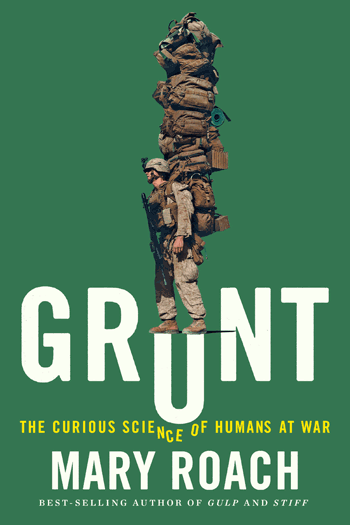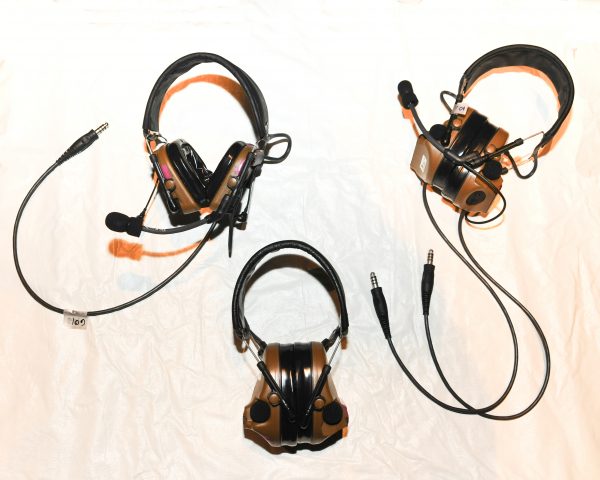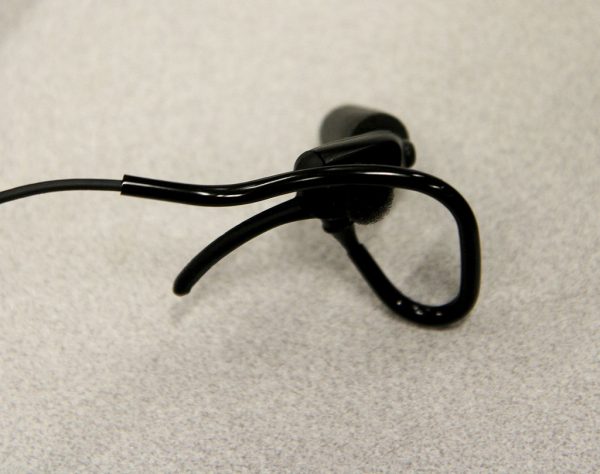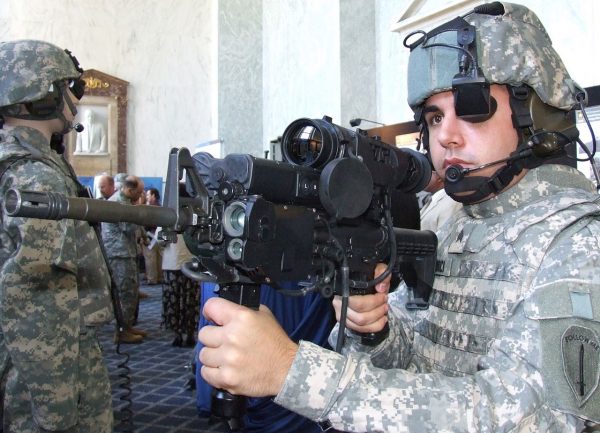The United States Marine Corps buys a lot of foam ear plugs. Visit any military base and you’ll find them under the bleachers at the firing range, in the bottoms of washing machines. They are cheap and effective at making noise less … noisy.

Most earplugs reduce noise by 30-some decibels, which can be significant. Every three-decibel increase in a loud noise cuts in half the amount of time you can be exposed without risking hearing damage. To put that another way: an unprotected human ear can spend 8 hours a day exposed to 85 decibels (freeway noise, crowded restaurant) without incurring damage. But if you go up to 115 decibels (chainsaw, loud rock concert) your safe exposure time is only half a minute before your hearing could be affected.
In a military situation, a reduction of 30 decibels is especially helpful with a steady grinding background din such as the thrum of a Blackhawk helicopter.

But there’s a problem with earplugs on the battlefield. Soldiers won’t wear them. If they do wear them, they may miss other important (softer) noises happening around them. The result is lots of service members coming home from battle with tinnitus or hearing loss. In fact, for as long as the U.S. Department of Veterans Affairs has reported such statistics, tinnitus and hearing loss have remained the number one and two most common injuries of service members.
Doctor Eric Fallon, former chief audiologist at Walter Reed Medical Center and now on the staff at 3M, is looking for solutions. He says the noise environment of the modern battlefield can change very quickly.
Service members need hearing protection that allows them to hear quiet noises and protects them when things get loud. In a combat situation, soldiers depend on their hearing to help them figure out what to do when things escalate quickly on the ground. A routine patrol, for instance, may suddenly come under fire without warning.
An important tool in these situations is the two-way radio. With a radio you can connect to someone who has a better view of the scene, which may be another soldier on the ground or someone monitoring from above with a drone camera. But with gunfire all around them, soldiers may not be able to hear the communications on their radios.
Eric Fallon believes the solution to all of these problems is a device called TCAPS (Tactical Communication and Protective Systems). Designed as either internal earbuds or external earmuffs, TCAPS protect a person’s hearing while still allowing them to hear the world around them through built-in environmental microphones. In some cases, these devices are integrated with radio capability.

TCAPS work thanks to sophisticated technology that detects high-decibel noises then lowers their intensity; they also pick up and amplify soft background noises. The result is a more balanced experience of sound, providing protection for the wearer while facilitating situational awareness.
Producers Katie Mingle and Sam Greenspan tested sets of integrated-radio TCAPS outside of the 99pi offices. They found that nearby conversations could be heard clearly, while louder construction noise nearby was reduced to tolerable levels. This allowed Katie and Sam to communicate while protecting their ears.

TCAPS have been around since the early 2000s, but so far have been mostly used by special forces (with little or no use by conventional ground forces). Eric Fallon says it’s been difficult to get the military to invest in this kind of hearing protection. He has to make the argument that TCAPS not only protect hearing but also make soldiers more effective on the battlefield.
The need to resort to such arguments points to a larger disconnect between the Department of Defense, which is tasked with defending the nation, and the U.S. Department of Veterans Affairs, which provides healthcare to veterans. If the DoD is given a choice between spending their money on bombs or hearing protection, it’s not hard to see why they might choose to kick the can to the VA.

To its credit, the Department of Defense has developed a growing awareness of the hearing problem. They do more testing now than ever before and in 2009 the DoD established The Hearing Center of Excellence. The center serves as an advocate for the reduction of noise-related injuries in the military.

Colonel Mark Packer, director of the center, sees TCAPS as effective but only part of the solution. Over-the-ear TCAPS can be hot and sweaty, so many soldiers will seek relief by removing them. To a gear-laden foot soldier, they may end up being perceived as just one more thing to carry. Another factor limiting the use of TCAPS is expense: they cost anywhere from about $280 (for a set that does not connect to radio) to upwards of $2,000.
Whether TCAPS are the solution for all combat troops or not, Colonel Packer of the DoD and Eric Fallon of 3M are both working (sometimes together) to find a solution to one of the oldest and most prevalent but also most invisible problems facing the military.



Comments (10)
Share
After listening to this episode, while sitting next to an active construction zone in my office, I researched TCAPS online. I came across this interesting challenge coin, made by 3M: http://www.ebay.com/itm/3M-TCAPS-Hearing-Protection-You-Cant-Fight-If-You-Cant-Hear-Challenge-Coin-/252343756188.
Very good episode, always fascinated by the endless complexity of modern warfare.
While a world without war would be amazing the fact remains that it is necessary due to the inherent nature of humans and the unavoidable flaws of all civilizations.
P.S. Helmet cam videos are addictive…
I’m an 18 year military veteran, and I have had tinnitus for a while. I usually only notice it when the ambient noise level is low. Unfortunately, ear protection (or Ear Pro), wasn’t as well enforced as it is today. Even within the last few years, I have forgotten mine during a rifle range. I spent the next few days hearing everything as if I was at the bottom of a well. If there was a way to integrate the system into our helmets, I would be willing to give it a try. Like any other piece of military equipment, if the thing doesn’t work, it gets tossed aside to make room for something that does.
I’m a 16 year Infantry veteran and I’m completely deaf in my right ear.
We had ear protection but for the reasons listed in this article, no one wore them. We didn’the even wear them to the firing range because the few times people bothered they would end up missing an important command and the potential for danger becomes huge when people can’t hear commands at military firing ranges.
Even without the danger, watching the person that missed the condition getting beasted is enough to put anyone off wearing ear muffs in the future lol.
I would disagree that battles on became noisy with the advent of gunpowder. Before that it was normal for armies to be accompanied by drummers with the goal of intimidating others. Moreover, I imagine that the clash of metal armor would be also incredibly noisy.
As an aging boomer and a professional Audio Video producer, I value my sight and my hearing. About 5 years ago I noticed a slight ringing in my right ear. The onset of Tinnitus. Now with my right ear at a constant ringing, my left ear will suddenly ring then “back down” to normal. I learn to live with it and sometimes use it to my advantage when my wife is asking me to do something around the house… If i become independently rich, I will invest in working on a cure for both Migraines, (for my daughter) and Tinnitus.
Katie/Mary, we at TEA Headsets currently supply and manage the only “approved” products and systems for the US Army TCAPS program. The system currently fielded/issued to several active US Army BCT’s is the INVISIO X50 Advanced Tactical Headset System with the INVISIO X5 dual in-ear headset. This program covers a variety of soldier applications, such as:
– Non Radio Hearing Protection System (provides the highest level of certified hearing protection and enhanced 360 degree auditory awareness)
– Single/Dual Net Radio Hearing Protection (provides same as above as well as integration into portable 1-2 radios as well as vehicle intercom systems).
To learn more about these products go to http://www.TEAheadsets.com or feel free to contact our Director of Business Development to learn more about the next generation of the TCAPS program, hearing protection solutions currently in use at a program level across the other branches of the DoD and the future direction of these products and systems.
Is that snippet of a “loud concert” the band Alergic to Bullshit??
Do i havta produce a coin to get an answer? ;)
Or maybe is it Los Canadians?